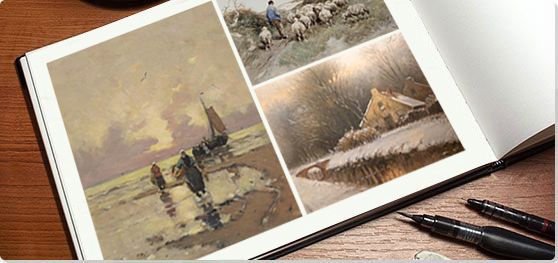Once there were two paintings
One colorful and beautiful
And the other simple and honest
* That simplicity and truth are the characteristics
of science and of art.
Well, people cannot understand that.
It was to the tinsel that they gave their favor."
Summary of The Hague School
The Hague School took its name from the coastal city in the Netherlands where a group of Dutch artists lived and worked roughly between 1860 and 1890. Influenced by the landscapes of the Dutch Golden Age and the French Barbizon School, the Hague School reacted against traditional academic painting, putting emphasis on realistic representations rather than idealized or romantic imagery. Painting rural landscapes and scenes of coastal life, their en plein air ("in open air") works emphasized atmosphere and mood while employing a sombre and muted color palette that lead to the group being dubbed the "Gray School". Writing in 1875, the Dutch critic Jan van Santen Kolf wrote, "They have revealed the poetry of grey in a hitherto unprecedented [sic] manner. In that grey atmosphere they find the ideal gradations of tone that they are looking for and we must recognize with admiration that they succeed in rendering what people had no idea of before with a fine sensitivity". A young Vincent van Gogh spent periods of time working and studying with the School that can take credit for leading Dutch art through its evolution into the modern age with the birth of Amsterdam Impressionism.
Key Ideas & Accomplishments
- Before the nineteenth century, the major tendency in art had been to idealize the landscape. The new century saw a shift away from the conventions of Classicism towards a more detailed, more realistic, approach to the landscape. The philosophy of Naturalism became one of the most important trends in nineteenth century art, providing a bridge in fact between academic art and Impressionism. Coming to the fore in the later part of the century, the Hague School artists came as close as any of the Naturalists to replicating the actual experience of standing in meadows and woodlands.
- One of its earliest pioneers, Gerard Bilders brought a further dimension to the School by introducing livestock into his landscapes. Indeed, this became a signifying feature of the School and was realized more fully by the likes of Anton Mauve and Józef Israëls. Later, Willem Maris specialized in animal paintings, even producing a highly regarded "Duck" series that moved away from the grey tones in favor of an expressive, impasto, treatment. This approach earned Maris the mantle of "Hague School Impressionist".
- The School's focus on its locality to the Hague extended to adjoining coastal regions where the beeches and shorelines meet with the North Sea. Artists such as Jacob Maris and Johan Hendrik Weissenbruch expanded the fixed definition of Dutch landscape painting by translating, through oils and watercolors, the distinctive weather and lighting conditions produced where the extended low horizon of the flat sea meets with the expansive sky.
- While the landscape remained the dominant subject in the Hague School's paintings, the group was willing to "move with the times" by recording the changing Dutch landscape as it was being transformed by the building of railways, canals and bridges. It was the Hague School artists who provided the lasting aesthetic and historical record of the Netherland's transition into a modern industrial nation.
- While it invariably reflected the brooding "gray mood" of the Dutch landscapes, the School was willing to accommodate different positions, such as that of Paul Gabriël who proclaimed, "Our country is saturated with colour. I repeat, our country is not grey, not even in grey weather, nor are the dunes grey".
Overview of The Hague School
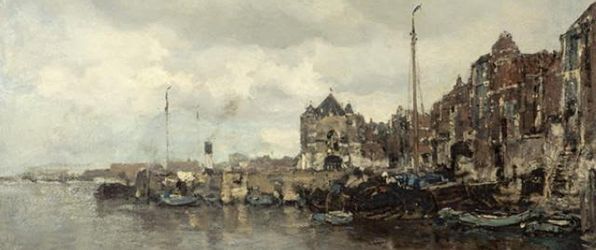
The masterful and atmospheric oil and watercolor paintings of Jacob Maris reveal, according to the art critic Theophile De Bock, an "intimate acquaintance with colour in all its gradations" and that the "charm they exert" comes from "the nobility and loftiness of spirit ever unconsciously reflected in this great artist's work".
Artworks and Artists of The Hague School
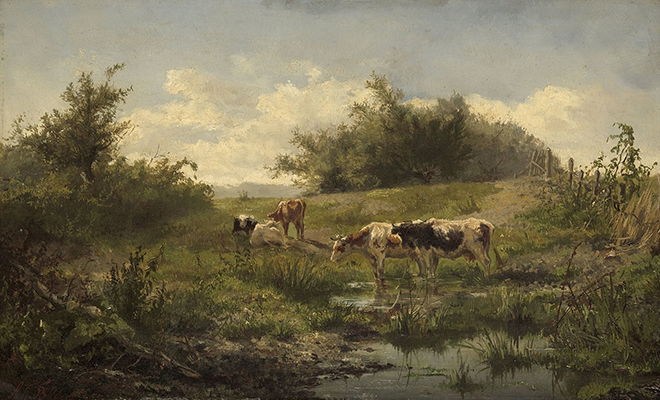
Koeien bij een plas (Cows at a Puddle)
It was through the exhibition of superior landscapes such as Cows at a Puddle that Bilders was able to launch the Hague School in 1860. This meadow landscape, probably painted at Oosterbeek, depicts several cows gathered at a large puddle, two of them standing in water, while three others rest on the grass, their forms huddled in an inverted triangle that creates visual movement between the open horizon and the pond. Framed by copse and shrubbery, as well as a fence overgrown with vines on the right, the scene conveys a mood of tranquil seclusion, enhanced by the grey tonalities. Lit with reflections and shadows cast by the long grasses, the pond in the foreground is more sharply focused than the rest of the soft and hazy image.
This work is an outstanding example of Bilders's preference for "a colored, fragrant warm grey" that captured the light of his native landscape, and in so doing, came very close to conveying the experience of actually standing in the landscape. What Bilders described as van Ruisdael's "landscape as a whole" principle, became fundamental to his own artistic worldview. As he wrote in 1861, "It is not my aim and object to paint a cow for the cow's sake or a tree for the tree's, but by means of the whole - to create a beautiful and huge impression which nature sometimes creates, also with most simple means".
Oil on panel - Rijksmuseum, Amsterdam, Netherlands

Kinderen der zee (Children of the Sea)
This beach scene shows four children, probably from the same fishing family, as they wade through the shallows of the sea in thrall of a toy boat. Unified in their play, the group conveys a sense of intimacy and familial togetherness. The oldest child carries the youngest piggyback, while another child, carrying a branch, holds onto his hand. A young girl stands to the left of the boat, its tiny white sail unfurled. Here, subtle grey tonalities are enriched with shades of blue, white, and light brown. The ocean's breaking white caps echo in the white head coverings and smocks of the children and in the boat's sail; they are in perfect balance with their natural environment (as the painting's title confirms: "children of the sea").
Though he had an extensive academic art education, Israëls followed the example set by Jean François Millet at the Barbizon School and settled in rural surroundings: in his case a small fishing village near Haarlem. Indeed, Israëls was dubbed "the Dutch Millet" and became a leading artist of what was be called "the second Dutch Golden Age". This painting was one of his favorites, and he described it as "an unicum" (unique example) because, in his words, "few pictures by me, have so many figures, busy in the subject". He was also celebrated for his engravings. As the art historian A. M. Hind wrote, his "few plates of peasant life, strong in line, powerful in chiaroscuro, rank directly with his paintings in the expression of the depths of human feeling, in which he was so worthy a successor of Rembrandt". The Venice Biennale honored Israëls with a retrospective exhibition following his death in 1911. He was a noted influence on van Gogh, and his son, Isaac, inherited his father's mantle as one of the leading next generation Dutch painters.
Oil on canvas - Rijksmuseum, Amsterdam, Netherlands
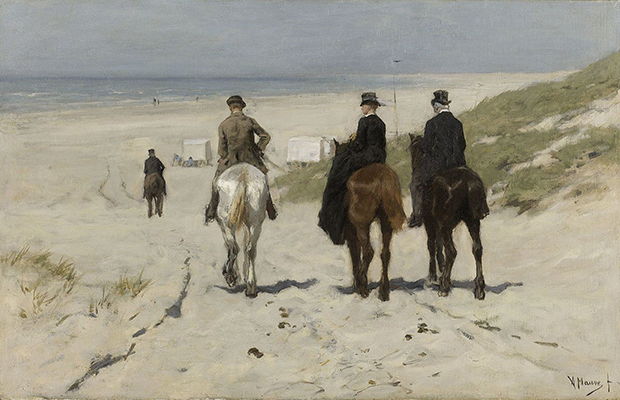
Morgenrit langs het strand (Morning Ride on the Beach)
This painting depicts a group of upper-class equestrians, riding away from the viewer, as their horses meander down a sandy path toward the beach at Scheveningen. Two men, fashionably dressed in top hats, jackets and jodhpurs, flank a woman riding sidesaddle, while another man, similarly dressed, is some distance ahead. Three white bathing cabins, along with a few bathers dressed in blue, are visible on the beach. Though a stylish nonchalance marks the riders and the scene, the art historian M.E. Weiseman noted that "An unconventional detail, horse droppings in the foreground, attests [to Mauve's] commitment to realism". At the same time the treatment is impressionistic; broad expressive brushstrokes creating the shimmer of light on the horses' flanks and on the moving bright haze of a seaside morning. Mauve, with the other Hague School artists, attempted, in Weiseman's words, "to recreate the natural effects of light and atmosphere by depicting not only isolated weather conditions, but also more subtle seasonal variations".
Mauve was married to Vincent van Gogh's cousin, and in 1881 van Gogh moved to The Hague to learn painting from him. Following Mauve's death, van Gogh was to dedicate his Pink Peach Tree in Blossom (Reminiscence of Mauve) (1888), which he described as "Probably the best landscape I have done" to him.
Oil on canvas - Rijksmuseum, Amsterdam, Netherlands
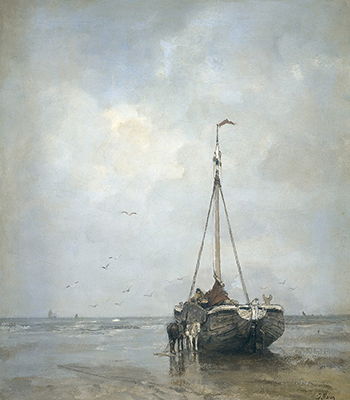
Bluff-bowed Fishing Boat on the Beach at Scheveningen
This landscape foregrounds a single fishing boat, its sails furled, resting on the beach where it has been towed by the two horses harnessed to its hull. The triangle of the mast and rigging creates a vertical movement, up toward the sky's gray clouds breaking into small patches of clearing. The cold gray Atlantic extends toward a low horizon of small white caps and sea birds wheeling in the air above the sails of a distant fishing boat. Gray predominates, as subtle gradations of the color both unify and distinguish the reflective water, the stolid boat, the extending ocean and the expansive sky. The tired horses, the single old fisherman sitting on the boat, and the vessel's gray-worn appearance convey the atmosphere of solitary labor, though this is lightened somewhat by the uplift of the sky.
Maris often painted the bluff-bowed fishing boats of Scheveningen, a small fishing village on the North Sea coast, not far from The Hague, in order to explore atmospheric effects. While he undertook preparatory work outdoors, due to fluctuations in the light, he often finished the paintings in his studio, because, in the artist's own words, he felt the need "to exaggerate in order to learn about the power of colours".
Oil on canvas - Rijksmuseum, Amsterdam, Netherlands
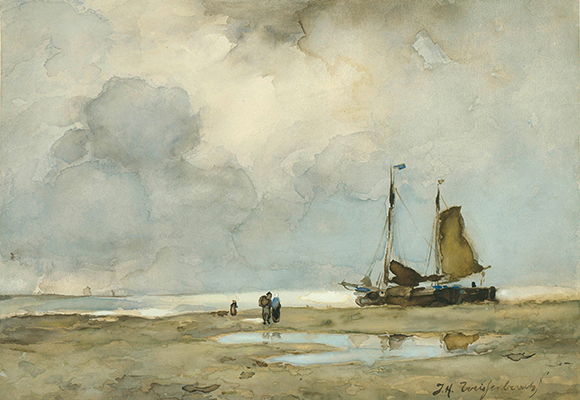
Beach Sight
A limpid grey tonality permeates this watercolor in which a boat with two masts rests in profile along the edge of the sea while three small human figures occupy the center frame. The tidal pool, partially reflecting the boat's sails, and luminous with a bluish light that reflects the color of the sky, draws the viewers' attention up toward the figures and the vast expanse of the ocean beyond. The lines of the ship, the coastline, and the low-lying horizon, convey a sense of nature's expanse which is further emphasized by the inclusion of the scene's human figures. Painted with fluid and delicate brushstrokes, with an effect that sometimes resembles a wash, the limited color palette creates an atmospheric effect which is dominated by the sky. As Weissenbruch wrote, "The sky in a painting, that is what is most important! Sky and light are the great magicians. The sky determines what the painting is. Painters can never pay too much attention to the sky".
Born into an artistic family, Weissenbruch was a lifelong denizen of The Hague - with the exception of one notable excursion (aged seventy) to France where he painted Forest View near Barbizon (1900). He undertook drawing lessons when he was sixteen and by the age of nineteen he had enrolled as a part-time student at the Royal Academy of Arts, producing works in a Romantic style before becoming one of the leading lights of the Hague School. The contrast between sky and water would become something of a motif in his work which he rendered through his career through both oils and watercolors.
Watercolor - Rijksmuseum, Amsterdam, Netherlands
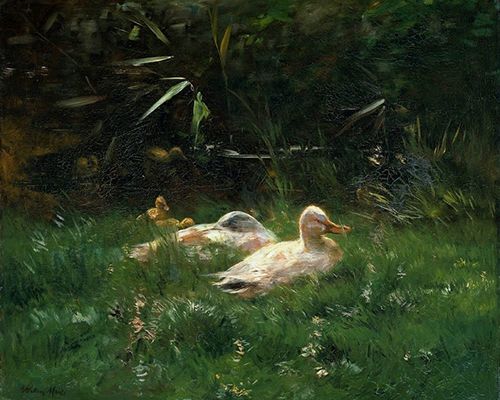
Ducks
In thick grass, its green brought alive with daubs of color, a pair of ducks rest with two ducklings, visible immediately behind them, and two others, almost hidden in the dark pond behind them. The duck in middle, lighter in color, is resplendent with light, an effect enhanced by the diagonal line created by the pointed fronds reaching out above the dark pond and carried into the line of the approaching ducklings and the echoing bright patch on its mate's back. The verdant green was a distinguishing character of Maris's style, created by impasto touches of pigment and loose brushwork that creates a soft, almost misty, effect.
The youngest of the Maris brothers, Willem described his early artistic beginning thus: "From the time I was young I worked outdoors. Even before I was twelve I would sit in the meadow and watch the cows before and after school. As my brothers were older than me, naturally I got part of my training from them [...] In the summer I always studied outdoors, and in the winter in the stable". Pieter Stortenbeker, known for his painting of cattle, also advised him, and Maris's first work was Cows on the Heath (1862), painted following his visit to Oosterbeek where he met Mauve and Gerard Bilders.
Throughout his career, Maris continued to paint primarily meadow landscapes, often with cows, and then later ducks and chickens. He insisted however, "I don't paint cows, but rather effects of light" and that that preoccupation with light informed his development from his early mood pieces to his vibrant coloring in later life. His brushwork also became looser, and included impasto, with the result that he was dubbed the Hague School's "Impressionist".
Oil on canvas - Rijksmuseum, Amsterdam, Netherlands
Beginnings of The Hague School
Jacob van Ruisdael and Paulus Potter
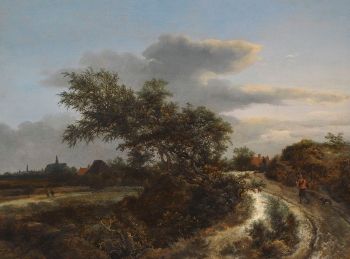
The Hague School artists absorbed the influence of the 17th century painter Jacob van Ruisdael, the Dutch Golden Age's pre-eminent landscapist, and Paulus Potter, well known for his paintings of farm animals. Van Ruisdael, one of the most famous landscape painters of 17th-century Holland, adopting a Naturalistic approach; his trees and shrubbery rendered with a botanical precision and an evocative use of color that could convey a brooding poetic ambiance that ranged from to the romantic to the tragic. One of his early landscapes, Dune Landscape near Haarlem (1647), for instance, placed the tree-covered dunes at the center of the composition to create a heroic sense of landscape, where figures and a distant buildings convey human activity as a detail in part of a larger, all-powerful, natural landscape.
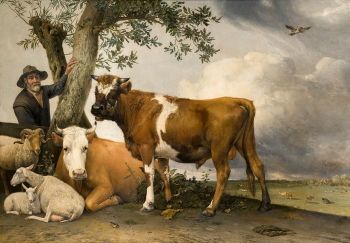
Potter's monumental life-sized painting De Stier (The Bull) (1647) was one of the most celebrated paintings in all the Netherlands; so celebrated, in fact, Napoleon seized the work and took it to Paris in 1795 where it hung in the Louvre (until an 1815 treaty saw it returned to its rightful home in the Netherlands). Potter's portrayal of the bull was noted for both its realism and its heroic treatment of an animal. Indeed, the subject resonated with the Dutch people for whom the bull had become a symbol of prosperity and of an independent Dutch Republic.
Johannes Warnardus Bilders
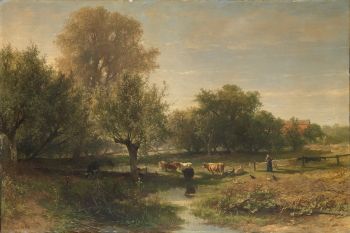
In 1841 Dutch landscape artist Johannes Warnardus Bilders moved to Oosterbeek, a village in eastern Netherlands that would become the destination of choice - the "Barbizon of the North" as it was dubbed - for a group of progressive Dutch landscapists. Beginning in 1830, the Barbizon School, located near the Forest of Fontainebleau in France, was a loose association of artists including Jean-Baptiste-Camille Corot, Jean-Francois Millet and Théodore Rousseau. Like the Barbizon, Bilders advocated naturalistic treatments of landscapes and scenes of rural life and he exerted a dominant influence over many Hague School artists who flocked to the region. Critic Max Rooses described Bilders as a "great interpreter of nature" and his students included his son Gerard, Anton Mauve, the Maris brothers and Paul Gabriël (all active in The Hague School). Many Hague School artists retreated to Oosterbeek, often spending an entire summer painting landscapes in the meadows and forests.
Gerard Bilders

Having spent the first eighteen years of his life in Utrecht (save the four year period between 1841-45 where the Bilders family lived in Oosterbeek), Gerard Bilders (Johannes's son) moved to The Hague in 1857. While studying at the Academy of Visual Arts, he often visited the Mauritshuis Museum where he assiduously copied works by Potter and van Ruisdael. He admired them especially for showing "the landscape as a whole" and for creating an effect of "unity" that was so compelling he felt as if he were experiencing nature first-hand. Bilders also forged links with future Hague School members, Jacob and Willem Maris, and Mauve. By 1859 Bilders was painting the Dutch landscape and developing a unique style that he described as "a colored, fragrant warm grey". As he wrote in 1860: "I am searching for a tone, which we call 'colored grey'. I mean that all colors, even the strongest, can be brought together in such a way as to give the impression of a warm, vital grey". Though he died suddenly at the age of just twenty-six (in 1865), his grey tonalities and his subject matter - typically landscapes depicting cattle at pasture - gave the Hague School its early aesthetic impetus which was developed subsequently by the likes of Mauve and Józef Israëls.
Pulchri Studio
Johan Hendrik Weissenbruch, Willem Roelofs, and Johannes Bosboom founded the Pulchri Studio in the home of the Hague painter Lambertus Hardenberg in January 1847. The goal was to provide training and development opportunities for artists who shunned the metropolitan centers of Amsterdam and Rotterdam in favor of The Hague's lush rural surroundings, and its close proximity to the picturesque fishing village of Scheveningen. Including a workshop with drawing from life models, the Pulchri Studio also functioned as an artist's association, accepting both working artists and art collectors as members, and holding art appreciation (Kunstbechouwingen) gatherings where artists could present their works and connect with fellow artists and collectors. The Pulchri Studio became a bastion for the Hague School painters, most of whom passed through its doors.
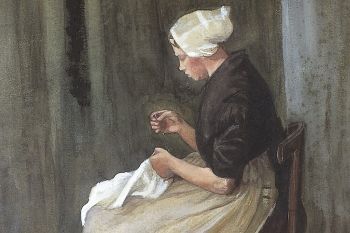
A friend and relative (by marriage) of Mauve, the emerging artist Vincent van Gogh, spent a productive period in the Hague and the nearby fishing village of Scheveningen between 1881 and 1883. Van Gogh became an associate member of Pulchri Studio in the fall of 1881, and though his membership lapsed after six months, it allowed van Gogh to interact with other artists and to finesse his life drawing skills twice weekly (saving him the expense of hiring his own models). It is also a matter of record that Van Gogh attended one or more art appreciation sessions on the tableau vivant and participated in the Exhibition of Living Masters, held every three years at the Studio. (It is known, too, that Blommers approached van Gogh about the possibility of giving a lecture on his personal collection of magazine illustrations, though in the event, the Pulchri Board rejected Blommers's proposal because it did not attach artistic importance to graphic works.)
The Laren School
By the mid-1880s the members of the Hague School began to disperse. The character of The Hague was becoming lost to rapid urbanization while the area around the small fishing village of Scheveningen was being transformed by the building of new suburbs and factories. Weissenbruch, Willem Roelofs and John Hendrik had altered their aesthetic outlook and set off in search of the bright, open, skies of the Dutch polders. Israëls, and his son, Isaac, had been drawn rather to the unspoiled natural beauty and farming life in Laren, a village situated in the heathlands east of Amsterdam.
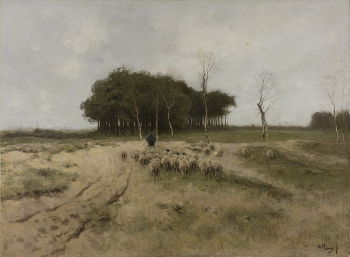
From 1882 Mauve painted in the largely barren surroundings of Laren where he often sketched flocks of sheep which he then turned into large compositions in his studio. Albert Neuhuys and Mauve moved to Laren (in 1883 and 1885 respectively) and established what became known as the Laren School; a thriving art colony that continued the Hague School tradition of realistic farmhouse interiors and plein air landscapes. Led by a second generation of Hague artists including Willem de Zwart, George Hendrik Breitner, and Willem Bastiaan Tholen, the Laren School had, however, started to consciously absorb the influence of Impressionism. This preference for looser brushwork and a lighter color palette would lead subsequently to a desire to represent cityscapes and the birth of Amsterdam Impressionism.
Concepts and Styles
Landscapes
The Hague School artists worked outdoors to capture the ambiance of everyday living through landscapes based predominantly on two settings: coastal scenes, often featuring elements of fishing life, and meadow scenes, usually featuring scenes of daily farm life. Bilders was primarily known for his meadow scenes, while Israëls and Maris were drawn more to the grey and sombre light of Holland's North Sea coast. Some artists explored a more diverse range of subject matter with Mauve known, in addition to his "sheep paintings", for his rural snow scenes and paintings of the Scheveningen coast.
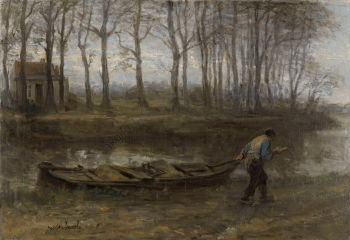
The Hague School was also drawn to subjects that reflected the changing Dutch landscape as industrialization, which came relatively late to the Netherlands, encroached on the landscape through the construction of railways, canals, bridges and telegraph poles. The image of the new Dutch landscape was reflected in works such as Israëls, The Sand Bargeman (1887), which addressed the theme of land being reclaimed from the sea, rivers and marshland through steam-driven pumping mills and drainage canals. Here the sand bargeman is transporting sand from the newly levelled dunes of the Hague. It was a theme mirrored by state commissioned photographers such as Johann Georg Hameter who, in images such as Railway Bridge over the Meuse nearby Rotterdam (1877), documented the building of public projects at the dawning of the modern Netherlands.
Interior Scenes
Though known primarily for their landscapes, when the wintery Dutch weather was at its worst, the Hague School artists were unable to work outside and so often turned to interior settings for inspiration. Israëls was particularly noted for such scenes. In his Alone in the World (1881), for instance, an elderly man sits alone in a room beside the bed where his wife has just died. His domestic scenes, often compared to those of Rembrandt, were celebrated for their compassionate and tragic but realistic treatment, with the French art critic Edmond Duranty describing his interiors as full of "shadows and grief". The mother and child was a common motif in interior scenes, and the direct influence of Israëls could be seen in the work van Gogh who, following his move north from the Hague to Drente, began working on several versions of The Potato Eaters (1885).
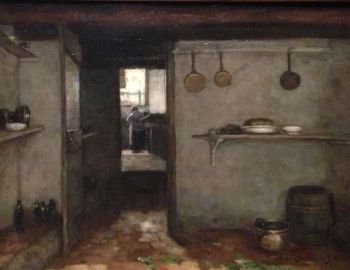
With Cellar of the Artist's Home in The Hague (1888) Weissenbruch had also turned to interiors; his view of his own cellar rendered through a muted palette of browns and grays contrasting with the studied effects of light falling through the cellar window (and even the detail of some discarded green cabbage leaves on the tile floor in the near foreground). While also painting interior scenes of farm life, such as his Interior of a Farm near Hilversum (1827-1891), Bosboom was known for his unique emphasis on church interiors, such as his Bakenesserkerk, Interior (1870), which showed several villagers in the hushed atmosphere of a Gothic church.
Watercolors
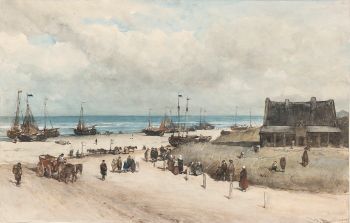
The Hague School became known for their watercolors which they regarded as freestanding artworks rather than mere preliminary studies for oil paintings. Johannes Bosboom was especially revered for his scenes of the interiors of churches and his landscapes, such as his The Beach at Scheveningen (1873). Other noted watercolorists included Mauve, Weissenbruch, Israëls, Jacob Maris and Hendrik Willem Mesdag. Israëls was in fact a founding member of the Dutch Watercolour Society, formed in 1876, and, with Bosboom, regularly exhibited at the Society.
The influence of the Hague watercolorists spread to America through the landscape and marine paintings of Emile Albert Gruppe. The son of Charles Paulo Gruppe, himself a one-time member of the Hague School, and later an art dealer for Dutch painting in the US, Emile spent his early years studying in Holland and became a member of the Pulchri Studio. He won several honors on his return to the US including a silver medal for oils and watercolors at the 1904 St. Louis Exposition. He was also a member of the New York Watercolor Club and the American Watercolor Society.
Later Developments - After The Hague School
According to the National Galleries of Scotland, by 1880 Glasgow ranked as one of the finest and richest cities in Europe with its economic success giving rise to "a growing appreciation of creativity [from which] a thriving art market emerged". Glasgow attracted a number of wealthy industrialists and mercantile collectors who shared a preference for modern art and "Commercial Glasgow art dealers such as Craibe Angus and Alexander Reid were displaying works by Barbizon and Hague School artists in the windows of their dealerships". The influence of Dutch and French landscapists proved inspirational for a loose group who, leading into the early years of the twentieth century, became known as the "Glasgow Boys" (or locally just as "the boys"). Made up of radical young painters including James Guthrie and John Lavery, the Glasgow Boys were, like their Dutch and French predecessors, united in their disillusionment with academic painting and turned, with their muted palettes, to scenes of rural subjects and everyday working life.
The approach of the Hague School painters was taken forward by the Amsterdam Impressionists who, like their French counterparts, put the modern city at the forefront of their paintings. Having already established himself as a painter, Breitner became a noted photographer too. Some of his paintings were composed from photographs, such as The Singel Bridge at the Paleisstraat in Amsterdam (1896-98), that shows a woman walking towards the viewer (viewfinder) in a cropped image that is conspicuously photographic in its composition. Breitner produced an impressive photographic portfolio largely based around the streets of Amsterdam featuring mostly working-class figures and children at play. The Hague School also had a noticeable impact on Dutch Pictorialist photographers such as the Haarlem-based Adriaan Boer whose heath landscapes, such as Towards the Fold (1905), was highly reminiscent of the Hague School, and of Mauve in particular.
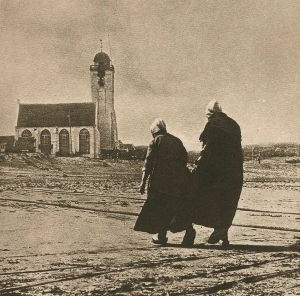
The Scottish Pictorialist James Craig Annan, meanwhile, arrived in the Netherlands in 1892 where he produced hundreds of landscape photographs. He wrote "All is cold and grey for it is early spring and last year's grass is only a shade deeper than the sand, which stretches hillock beyond hillock until they meet the greyer sky, which westward blends into the horizon of the sea". Annan was the key influence on the development of art photography in America having exhibited at Alfred Stieglitz's Photo-Secession Galleries in New York and also having published his work in the two leading photographic periodicals in America: Camera Notes, and Stieglitz's Camera Work. Indeed, during a tour of Europe in 1894 Stieglitz himself produced twenty "Dutch subjects" including Scurrying Home (aka: The Hour of Prayer, near the traditional village of Katwijk) (1894) which showed two fisher-women approaching a distant church in a composition that directly recalls the atmosphere of the Hague School paintings.
For its part, The Laren School, or The Laren Colony as it was also known, continued to attract artists into the early years of the 20th century. Indeed, during the First World War, Piet Mondrian took refuge at the Colony where he met Theo van Doesburg. The legacy of the Hague School has been kept alive, meanwhile, through the Pulchri Studio which continues to thrive as an artists' association and gallery, holding in the region fifty exhibitions annually.
Useful Resources on The Hague School
- Hague School BookBy John Sillevis and Anne Tabak
- Rural Artists Colonies in Europe (1870-1910)By Nina Lübbren
- Dutch Painters of the Nineteenth Century: With Biographical Notices, Volume 3Our PickBy Max Rooses
- The Hague School: Dutch Masters of the 19th CenturyOur PickBy Robakd De Leeuw, John Sillevis, and Charles Dumas
- A Reflection of Holland: The Best of the Hague School in the RijksmuseumBy Renske Suyver
